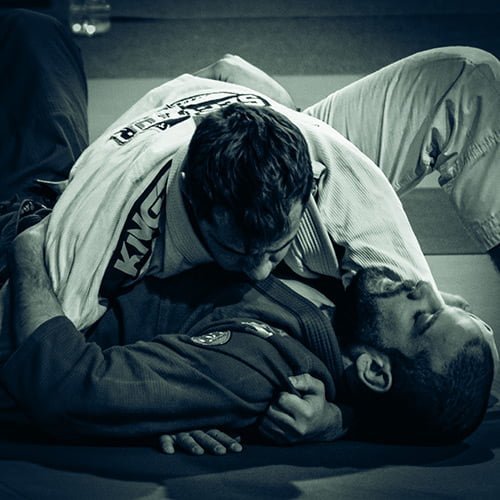Jiu Jitsu Triangle Choke
The triangle choke is an incredibly powerful submission hold that can quickly end a fight if applied correctly.What is aJiu Jitsu Triangle Choke?
The triangle choke is one of the most common and devastating submission holds in Brazilian Jiu Jitsu. It is a choke that attacks the carotid arteries and can cause an opponent to unconsciousness very quickly if done properly. The hold is commonly referred to as “taking the back” because of the common position in which it is applied.

A Jiu Jitsu Triangle choke is a chokehold that is applied by grasping the opponent’s head and one arm, and placing the other arm across the throat. The choke can be applied from a number of different positions, but is most commonly done from the guard position.
Jiu jitsu triangle choke from guard
To properly execute the triangle choke, the jiu jitsu practitioner must first place their opponents in the guard position. From here, they will use their legs to trap one of the opponent’s arms and then extend their other leg over the opponent’s neck. The final step is to use their free arm to apply pressure to the opponent’s trapped arm, cutting off their blood supply and causing them to submit.
The triangle choke is an incredibly powerful submission hold that can quickly end a fight if applied correctly. Any jiu jitsu practitioner looking to add this move to their arsenal should spend time drilling the proper technique so that they can execute it with precision in a live setting.
How to do a jiu jitsu triangle choke from guard
As we mentioned, the triangle choke is most commonly done from the guard. The guard is a position in Jiu Jitsu where one person is on their back with the other person standing in between their legs. To set up the choke, you will need to first take a grip on your opponent’s lapel with one hand and their collar with the other. From here, you will need to sit up and pull your opponent down towards you. As you do this, you will want to shoot your legs up and around their head and neck. It is important that you keep a tight grip on their lapel and collar throughout the entire process.
Once you have your legs in place, you will need to start squeezing your legs together. This is what will ultimately choke your opponent. It is important to keep your hips tight and squeeze as hard as you can. You can also help the choke along by putting pressure on your opponent’s chest with your free hand. Once your opponent is choked out, you can let go and they will be forced to tap out.
The triangle choke is a great submission to know because it can be used from a variety of different positions. It is also a relatively simple choke to execute, which makes it a great option for beginners. However, it is important to remember that this is a submission hold and should only be used in a competition or self-defense situation.
How to do a arm triangle choke in jiu jitsu
One of the most basic and important chokes in Brazilian Jiu Jitsu is the arm triangle choke. The arm triangle choke can be applied from a variety of positions, but is most commonly done from the guard. The reason the arm triangle choke is so important is because it can be applied from so many positions, and is also a very powerful choke. When done correctly, the arm triangle choke can render an opponent unconscious.
There are a few things to keep in mind when doing the arm triangle choke. First, it is important to make sure that your opponent’s arm is across their throat. This will ensure that when you apply the choke, they will be unable to breath. Second, you need to make sure that you have a good grip on their arm, so that they will not be able to escape the choke. Third, you need to make sure that you are applying the choke correctly, so that you do not injure your opponent.
Here is a step by step guide on how to do the arm triangle choke:
1) Start in your opponent’s guard. Make sure that their arm is across their throat.
2) Grab their arm with your opposite hand, and put your other hand on their chin.
3) Squeeze their arm and chin together, and push their head down with your hand on their chin.
4) As you are pushing their head down, rotate your body so that you are on your side.
5) Continue to squeeze their arm and chin together, and apply pressure with your body.
The arm triangle choke is a very powerful choke, and can be applied from a variety of positions. It is important to make sure that you have a good grip on their arm, and that you are applying the choke correctly. If done correctly, the arm triangle choke can render an opponent unconscious.
The choke is considered to be one of the most effective submissions in Jiu Jitsu, as it can be applied quickly and with little effort.
The Triangle choke is a blood choke, which means that it cuts off the flow of blood to the brain. This causes the opponent to pass out, and results in a submission.
The Triangle choke can be applied in a number of ways, but the most common method is to grip the opponent’s head with both hands, and then place the left arm across the throat. The right hand is then used to push on the left elbow, which tightens the choke.
The Triangle choke can also be applied from the mount position.
In this case, the attacker will place their left arm across the throat of the opponent, and then use their right hand to grip the back of the head. The attacker then uses their body weight to apply pressure to the neck, and cuts off the flow of blood to the brain.
The Triangle choke is a very versatile submission, and can be applied from a number of different positions. It is an incredibly effective submission, and is a favorite among Jiu Jitsu practitioners.
How to perform the Triangle choke hold submission move in Jiu Jitsu
1. The first step is to get your opponent into a side control position. From here, you will need to establish a cross-body grip on their far arm.
2. Next, you will need to place your head on the inside of their far thigh, and your far arm under their near thigh.
3. Now, you will need to use your free hand to grab their far ankle, and your near hand to grab your own far ankle.
4. The next step is to use your legs to trap their far leg, while keeping their near leg trapped with your arm.
5. Finally, you will need to use your legs to squeeze their far leg, while pulling down on their far ankle with your hand. This will cause their hips to rise off the ground, and their head to be pulled down into your triangle choke.

How to do a jiu jitsu triangle leg choke
One of the most powerful leg locks in Jiu Jitsu is the triangle leg choke. Often referred to as the “guard,” the triangle uses the legs to effectively control and submit an opponent. While it can be used from other positions, the guard is the most common place to set up the triangle. Here’s a step-by-step guide on how to do a jiu jitsu triangle leg choke from the guard.
Assuming you are in your opponent’s guard, the first thing you’ll need to do is open their legs. You can do this by placing your foot in the space between their legs and pushing outward. This will give you the space you need to slide your other leg through and establish the triangle.
Once your legs are in position, it’s time to start tightening the choke. The goal is to get your shin as close to their neck as possible while also trapping their arm. You can do this by placing your foot on their hip and using your opposite hand to push their head down.
As you tighten the choke, it’s important to keep your hips close to your opponent. This will prevent them from rolling out of the submission. Once the choke is tight, all you need to do is wait for your opponent to tap out.
The triangle leg choke is a powerful submission that can be used to great effect in Jiu Jitsu. By following the steps above, you can set up the choke and force your opponent to tap out.
Brazilian jiu-jitsu triangle choke hold
A triangle choke is a Brazilian Jiu-Jitsu hold that attacks the neck and airway. The hold is applied by placing one arm across the front of the neck and linking the hands, then using the other arm to lock the hold by placing the hand on the floor and grabbing the wrist. The legs are used to control the body by hooking around the opponent’s waist or thigh.
The choke can be applied from various positions, including the guard, half guard, side control, north-south, and mount. The most common position for applying the triangle choke is the guard. The guard is a position in which the practitioner is on their back on the ground, with their legs wrapped around the opponent’s waist.
The triangle choke is an effective hold because it can be applied with relatively little strength, and it is very difficult for the opponent to escape from. The hold works by cutting off the supply of oxygen to the brain, and it can cause the opponent to pass out if it is applied for long enough.
The triangle choke is a versatile hold that can be used in both offensive and defensive situations. It is an important hold for Brazilian Jiu-Jitsu practitioners to know, and it can be a useful tool for self-defense.
Jiu jitsu triangle choke escape
There are a number of different ways to escape a triangle choke, but one of the most common and effective is the jiu jitsu triangle choke escape. This escape involves using your legs and hips to create a space between your head and your opponent’s body, then shrimping out of the hold.
Here’s a step-by-step guide to escaping a triangle choke using the jiu jitsu triangle choke escape:
As your opponent begins to apply the hold, tuck your chin and bring your legs up towards your chest.
Create a space between your head and your opponent’s body by driving your hips up and pushing your legs out
From this position, shrimp out of the hold by crawling backwards with your legs. This will create enough space for you to slip your head out of the hold and escape.
If you find yourself in a triangle choke, don’t panic. Use the jiu jitsu triangle choke escape to create a space between your head and your opponent’s body, then shrimp out of the hold. With a little practice, you’ll be able to escape this hold and keep the fight going.
Triangle choke jiu jitsu techniques
Triangle chokes are one of the most common and effective submissions in jiu jitsu. They can be applied from multiple positions and often catch opponents off guard. In this article, we’ll go over some of the basics of applying a triangle choke.
When applying a triangle choke, you’ll want to start by getting into a good position. This can be done from the guard, half guard, side control, or even mount. Once you’re in a good position, you’ll need to isolate one of your opponent’s arms. This is usually done by trapping their arm with your legs.
Once you have their arm isolated, you’ll need to grab their head with both of your hands. You can then use your legs to apply pressure to their neck and head, forcing them to tap out.
Triangle chokes can be applied in a variety of ways and from multiple positions. Be creative and experiment to find what works best for you. With a little practice, you’ll be able to apply these chokes with ease.
